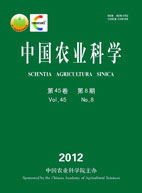-
超级稻|产量|时期|硅|硅素吸收、利用效率Effect of Application of Silicon at Different Periods on Grain Yield and Silicon Absorption, Use Efficiency in Super Rice
- GONG Jin-Long, HU Ya-Jie, LONG Hou-Yuan, CHANG Yong, GE Meng-Jie, GAO Hui, LIU Yan-Yang, ZHANG Hong-Cheng, DAI Qi-Gen, HUO Zhong-Yang, XU Ke, WEI Hai-Yan, LI De-Jian, SHA An-Qin, ZHOU You-Yan, LUO Xue-Chao
-
Scientia Agricultura Sinica. 2012, 45(8):
1475-1488.
doi:10.3864/j.issn.0578-1752.2012.08.003
-
 Abstract
(
1005 )
Abstract
(
1005 )
 PDF (353KB)
(
844
)
PDF (353KB)
(
844
)
 Save
Save
-
References |
Related Articles |
Metrics
【Objective】The objective of this study was to identify the best period for application of Si and the mechanisms of efficient Si absorption and use efficiency in super rice. 【Method】A field experiment was conducted with two japonica super rice varieties Wuyunjing24 and Huaidao9 planted on a large scale in Jiangsu region as materials exposed to applied Si at different periods. Grain yield and its components, Si accumulation at the main growth and development stage, periodic Si accumulation, periodic Si uptake rate, Si use efficiency, etc, were investigated. Furthermore, correlation analysis of grain yield and its components and traits associated with Si uptake and use efficiency was studied. 【Result】 Applied Si increased grain yield and its components, Si accumulation at the main growth and development stage, periodic Si accumulation, periodic Si uptake rate and partial factor productivity of applied Si, but it decreased Si use efficiency for grain production, significantly. It not only promoted Si supplies, but also improved the ability of providing Si of the soil. Morover, it raised available Si level in the soil and promoted Si absorption of rice. With the delaying periods of applied Si, grain yield, panicles, grains per panicle, total amount of Si absorption, Si uptake per 100kg of grain, Si recovery efficiency, Si agronomic efficiency and partial factor productivity of applied Si increased firstly and then decreased, while Si use efficiency for grain production showed an opposite trend, with applied Si at effective tillering reaching a peak for panicles and critical leaf-age for productive tillers for others. However, seed-setting rate and 1000-grain-weight followed an ascendent tendency accordingly, with 1000-grain-weight of applied Si at heading reaching a significant level, whereas Si physiological efficiency was not significantly correlated with the periods of applied Si. Si accumulation rate of rice were 20.69-29.02% from transplanting to panicle initiation, 47.46-59.65% from panicle initiation to heading, 17.99-25.52% from heading to maturity, panicle initiation-heading > transplanting-panicle initiation > heading-maturity, significantly, and the periodic Si uptake rate followed the same trend as it. Correlation analysis showed that, grain yield components of rice grew together with Si absorption in phase and there existed significant positive correlations between grain yield and total amount of Si absorption. The increase of periodic Si uptake rate and periodic Si accumulation from panicle initiation to heading improved by applied Si was the physiological basis of increasing grain yield improved by large panicle. 【Conclusion】Increase of periodic Si uptake rate and periodic Si accumulation, especially at panicle initiation-heading stage, could increase Si accumulation at heading and maturity satges and Si use efficiency. By achieving large panicle based on stabilizing and raising panicles, and promoting the enrichment of population sink, grain yield could be further improved by application of Si.









